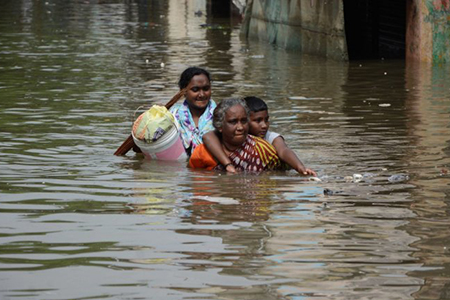I have survived three flood events in India. The first was in North Lakhimpur in 2008 in Assam, the second was in Kashmir in 2014 and the third is taking place now in Chennai. In all of these situations, I have been extremely fortunate. But most importantly, I have learned to read the signs of an impending natural disaster and take evacuative measures. In one situation, it meant wading through waist level water with a backpack balanced on my head to a pick-up location where I was given a ride by the local police (Assam), in the second situation in Kashmir, it meant leaving Srinagar after taking a good look at the Jhelum and knowing that it was going to flood two days before it actually did. In the case of Chennai, the flood situation was gradual because of the incessant rain for over one month and it was only much later that authorities and organizations began recognizing it as such.
 I am writing this piece because as a “flood veteran”, I have noticed certain patterns when it comes to a natural disaster like a flood. First, States are usually slow to recognize the situation as a natural disaster, in this case a flood. Unless it is a one-off cataclysmic event that takes place over the span of a few minutes or a few hours and kills many people in a short span of time, it is not quickly seen as a “natural disaster”. This severely hampers emergency and rescue efforts as the response time has already increased substantially. However, I must add that Kashmir was an exception last year. The authorities had issued a flood warning a good two days before the flood occurred. So why was there so much damage and loss of life?
I am writing this piece because as a “flood veteran”, I have noticed certain patterns when it comes to a natural disaster like a flood. First, States are usually slow to recognize the situation as a natural disaster, in this case a flood. Unless it is a one-off cataclysmic event that takes place over the span of a few minutes or a few hours and kills many people in a short span of time, it is not quickly seen as a “natural disaster”. This severely hampers emergency and rescue efforts as the response time has already increased substantially. However, I must add that Kashmir was an exception last year. The authorities had issued a flood warning a good two days before the flood occurred. So why was there so much damage and loss of life?
A curious thing about the sub-continent is that there is inertia on the part of people to take such warnings seriously. Warnings are issued so that people can self-evacuate or hunker down somewhere with provisions. In a highly populated zone, like Srinagar or Chennai, many believe that they can weather the storm. Instead of self-evacuating, they wait, thinking the situation will go away. However, warnings are issued precisely because if people self-evacuate then it is easier for the State to step in and take care of the residual trapped persons and families.
In Chennai, a brimming reservoir (Chembarambakkam) was releasing up to 5000 cusecs of water per second on December 1, but the warning only came a couple of hours before on social media. The residents of the Adyar estuary area, who are poor and not on social media, were unaware of the intended flooding of the region. This combined with about 201 mm of rain on December 1, meant that the nearby Kotturpuram area was badly affected, with ceiling levels of water in peoples’ living rooms.
In a crisis such as the one Chennai is currently undergoing, information is paramount. The Kashmir flood rescue was coordinated by the army and through social media, where locations of trapped persons were crowd sourced and sent to the army. Once the army stopped functioning a week later, individuals stepped in and rescued Kashmiri citizens. Essentially, in Kashmir, the central state’s actions were insufficient and the State government was seen as inadequate.
Tamil Nadu is luckier because at least it has a functioning independent State government. Police have been directing traffic and public services like buses and trains have continued to operate regardless of the rain. However, the inability of the State government to shut down the city including the industrial units affected the rescue efforts. There have been times over the past month that commuters have been stuck for between 4 - 18 hours on the roads. The lack of foresight on the part of prominent corporations in the city to issue flood advisories to their employees, even though the flood situation was apparent since last month, also resulted in employees being trapped at their places of work. Employees of one media house in Chennai were informed that they could stay home from work, but their leaves would be deducted. If they wanted to not have that happen, they would have to show up to work. It was not an immediate concern that there was a flood occurring.
There are several issues I will point out here. First, it is important to read the writing on the wall and be able to identity a potential crisis situation early on. In India, governments wait for the worst to happen before they start acting. A notable exception was Odisha. When Cyclone Phailin hit in 2013, Odisha had identified at-risk zones, identified government establishments as shelters and evacuated about a million people from their homes before the cyclone hit. Subsequently, the death toll was less than ten. Chennai city, for instance, should have been under limited lockdown for at least two days before the flooding, especially since the second low-pressure system to hit Chennai had already been predicted as early as November 27. On December 1, it should have been under full lockdown so emergency services could operate unhindered by commuter traffic.
Also, stepping out in a flood situation also means increasing the burden on the State as it increases the likelihood of more people being trapped and at risk. So, corporations should have issued flood advisories to their employees. This was not uniformly done in Chennai leading to deaths of employees trapped in their offices. Third, the State should have acquired boats and rafts much earlier instead of relying on fishermen’s boats, which are heavy and cumbersome to transport.
Hotels in Chennai were taking in people on a limited basis as they were running out of power and provisions. At least two hotels had to suspend operations as they ran out of food and water. In the Park Hyatt hotel, which survived going under, the staff stayed in the hotel for days at a stretch and their staff was busy sourcing diesel to run their generators. Food, power and water were limited, so the management chose to shut down half the hotel and focus instead on the guests staying there and rationing their provisions.
The Chennai flood was caused by excessive rainfall, of course. However, a second variable that affected the accumulation of such high levels of water had to do with rampant and unchecked urbanization. Chennai’s new economy, boasting of industrial plants on the outskirts of the city, knowledge corridors and information technology corridors, are being built on reclaimed land. What were previously old water bodies were filled in and built upon, with no understanding or attention given to storm water drainage and green spaces. Consequently, the rain when it fell followed its natural path to such areas, which were low-lying but contained concrete instead of natural water-bodies where water would go. The Chennai flood and similar floods in Assam, Kashmir, Uttarakhand point to a type of development that is being undertaken without taking into account the impact of unplanned and rampant construction that eats up green space. Oddly enough, the one neighborhood of Chennai, which was not badly affected was Besant Nagar, where green space still exists in individual houses and in the area at large. Needless to say, this is one of Chennai’s older neighborhoods.
The Chennai flood event also saw citizens’ initiatives spring into action. In many neighborhoods people went out and conducted their own rescue operations, delivered drinking water to trapped persons and other provisions. Blue Cross rescued animals. They were taken to shelters and many are being now placed for re-adoption. Strangers opened their homes to strangers and a weird disaster community is being forged, which will undoubtedly see the city through any other crises that arise.
(Vasundhara Sirnate is the Chief Coordinator of Research at The Hindu Centre for Politics and Public Policy.)
